I'm about to replace the rubrail on my E36-RH for the second time in about 12 years. I found a new product that looks really tough and somewhat simple to install... It's an Italian made rubrail available from Jamestown Marine. The brand is Tessilmare and the samples they sent me look strong enough to hold up for a long time. If you go to the Jamestown Marine web site they have a neat video on the rubrail installation process (http://www.jamestowndistributors.co...title=Tessilmare+Radial+Rub+Rail+Installation). The only installation issue I have is the lip around the hull-top-deck joint. It is sticking out too high to allow me to get the new rub rail close to the boat. I would like to belt sand or grind down the lip until it is almost flush with the deck and sides of the boat. The big question I have is... Is the lip structural (does the boat need it to hold the deck and hull together, or can it go away.
Has anyone had experience with getting rid of the lip? Has anyone had experience with the Tessilmare rub rail?
Has anyone had experience with getting rid of the lip? Has anyone had experience with the Tessilmare rub rail?





